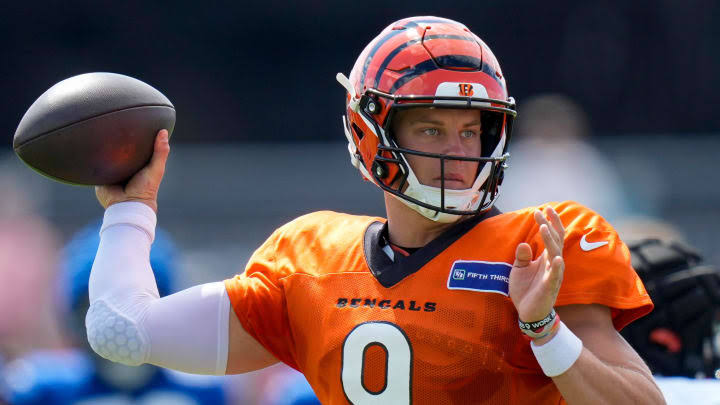## Joe Burrow’s Burglary: A Spotlight on Athlete Vulnerability and Security Concerns
Cincinnati Bengals quarterback Joe Burrow, one of the NFL’s rising stars, recently became the latest high-profile athlete to fall victim to a home burglary. The incident, while thankfully not resulting in physical harm to Burrow or his family, shines a harsh light on the vulnerability professional athletes face despite their fame and fortune. It underscores a broader issue: the precarious balance between public adoration and private security, a delicate equilibrium increasingly disrupted in the modern age of social media and readily available information.
While specifics surrounding Burrow’s burglary remain somewhat limited, owing to the ongoing investigation and respect for his privacy, the event itself triggers a cascade of questions. The incident raises concerns about the security measures in place for high-profile individuals, the ease with which criminals can target affluent homes, and the lasting emotional impact such invasions can have on victims.
The prevalence of similar incidents among professional athletes is alarming. From basketball superstars to baseball icons, countless athletes have experienced the violation of their homes and the theft of their valuable possessions. This isn’t simply a matter of opportunistic crime; sophisticated criminal networks often target athletes specifically, understanding their often-extensive wealth and the potential for significant financial gains.
Several factors contribute to athletes’ vulnerability:
* **Public Profiles and Social Media:** The very nature of being a professional athlete involves a high degree of public exposure. Social media, while providing a platform for connection with fans, also inadvertently provides criminals with valuable information. Public appearances, travel schedules, and even seemingly innocuous posts can reveal patterns and vulnerabilities in an athlete’s routine, offering potential targets for burglars.
* **Travel Schedules and Busy Lives:** The demanding schedules of professional athletes frequently take them away from their homes for extended periods. This absence, even if for only a few days, creates an opportunity window for criminals. The constant travel also means that athletes might not always have the time or resources to implement comprehensive security measures.
* **High-Value Possessions:** Athletes often acquire substantial wealth, leading to the accumulation of high-value assets. Luxury cars, designer clothing, expensive jewelry, and other collectibles become tempting targets for thieves. The perception of wealth, often amplified by public appearances and media portrayals, can inadvertently attract unwanted attention.
* **Lack of Adequate Security:** While many athletes employ security personnel, the sheer scale of the problem suggests that current measures are often insufficient. This could be due to the cost of comprehensive security systems, the difficulty in balancing security with privacy, or a lack of awareness regarding the sophistication of modern criminal tactics. The assumption that wealth guarantees safety is a dangerous fallacy.
The aftermath of a burglary extends far beyond the immediate loss of property. The emotional toll on victims is often significant. The feeling of violation, the sense of insecurity, and the fear that it could happen again can have lasting psychological consequences. This is particularly true for athletes who already operate under immense pressure and scrutiny. The invasion of their private sanctuary—their home—can be deeply traumatizing.
Moving forward, several steps can be taken to mitigate the risk of burglaries targeting athletes:
* **Enhanced Security Measures:** Investing in sophisticated security systems, including alarm systems, CCTV cameras, and motion detectors, is crucial. Employing professional security personnel, particularly during periods of absence, can offer significant deterrence.
* **Privacy Awareness:** Athletes and their representatives need to be acutely aware of their online presence and the information they share publicly. Limiting the details shared on social media and exercising caution regarding the disclosure of travel plans can reduce their vulnerability.
* **Collaboration with Law Enforcement:** Close collaboration between athletes, their security teams, and local law enforcement is essential. Sharing information and collaborating on security strategies can improve overall effectiveness in preventing and responding to burglaries.
* **Public Awareness Campaigns:** Raising public awareness about the issue and the steps that can be taken to prevent it is crucial. Educational campaigns could target not only athletes but also the broader public, emphasizing the importance of home security and responsible social media usage.
Joe Burrow’s recent burglary serves as a stark reminder that fame and fortune do not guarantee safety. It underscores the need for enhanced security measures, increased awareness, and proactive collaboration between athletes, their support networks, and law enforcement agencies to combat this growing problem. The incident should prompt a broader conversation about athlete security and the measures needed to protect these individuals from the pervasive threat of home invasion. Beyond the material losses, it’s the violation of personal space and the resulting emotional trauma that demand our attention and necessitate a concerted effort to enhance the safety and security of professional athletes.

